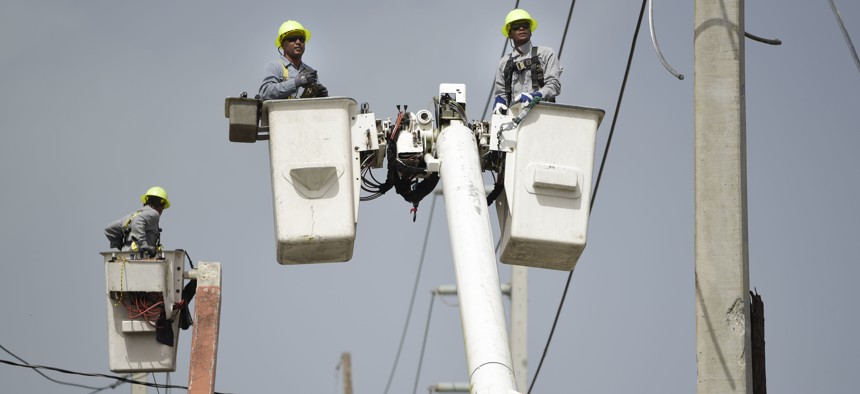Connecting state and local government leaders
Behind the scenes, the destruction has bred a keen contest for a massive prize: the 1.4 million customers of the Puerto Rico Electric Power Authority, which has kept its monopoly on the island for 70 years despite a dismal record.
SAN JUAN, Puerto Rico — Seven weeks after hurricane Maria, the traffic lights are still down in San Juan. The narrow, cobbled streets of the city’s historic center, one of the island’s top tourist attractions, turn pitch black as soon as the sun sets. With appliances useless during the blackout, many of the city’s residents can’t cook, store food, or take a real shower.
The Sept. 20 storm toppled the electrical system, and locals complain next to nothing has been done about it. “I haven’t seen anyone come around here to inspect the damage, let alone to fix it,” said Carlos Alberto Soto, who’s had to close one of the two restaurants he owns for want of power.
But behind the scenes, the destruction has bred a keen contest for a massive prize: the 1.4 million customers of the Puerto Rico Electric Power Authority (Prepa). With more customers than any other US electric utility, Prepa has kept its monopoly on the island for 70 years despite a dismal record. Maria has loosened its atrophied grip, and now various players are jockeying to supplant Prepa’s power supply, which relies heavily on fossil fuels, with everything from small solar-energy generators to imports of liquefied natural gas.
Prepa was already bankrupt before the storm, owing more than $9 billion—$2.7 billion more than what its rickety system was worth. In a single day, even that value was wiped out as the hurricane turned much of the company’s infrastructure from assets into scrapyard material. The cost of repairs is still unclear—Prepa had said it was in need of a $4.6 billion upgrade even before the storm—but officials supervising its bankruptcy proceedings say both federal aid and private funds will be needed.
So as the utility struggles just to turn the lights back on, solar companies, local businesses, environmentalists, the fossil-fuel industry, Prepa bondholders, and even the people who have run the company for years are all competing to plot the island’s electric future. The question is whether the contest will benefit Prepa’s already beleaguered customers, or leave them still hostage to poor service and high prices.
And at stake is far more than the size of people’s electric bills. Expensive electricity is a big reason why the whole island’s economy has been crippled for years—long before Maria struck.
The Prepa Model
A drive through the hilly terrain of Adjuntas, more than 100 km (62 miles) from coastal San Juan, is a testament to Prepa’s biggest accomplishment. Despite the hurricane, many electricity poles still line the tight roads winding up the mountains, connecting the modest concrete and wooden homes in the area to the island’s sprawling grid.
It wasn’t always so. Electricity reached Puerto Rico by way of a wealthy landowner, who in 1893 installed a generator to light up his home. In 1898 the island passed from Spanish to American hands. Five decades later, only 12% of its countryside residents had electricity. Angela Santana, a 64 year-old Adjuntas resident, remembers a childhood lit by gas lamps and candles—not all that different from how she’s living in the wake of Maria, she says.
But starting in the mid-1940s, Prepa’s precursor, the Water Resources Authority, launched an effort to electrify Puerto Rico to the last house. Adjuntas’s thick vegetation and steep drops show how hard that was. The authority sometimes had to use helicopters to set up power lines. Electricity arrived to Santana’s home by the time she was 10; by the time she was 20, virtually all of Puerto Rico had been connected to the grid, a feat that countries in Latin America such as Guatemala and Belize have yet to achieve.
This stunning achievement, however, also contained the seeds of Prepa’s downfall. Its mission accomplished, the agency became listless and inertial, like a zombie, says Sergio Marxuach, an energy policy expert at the Center for a New Economy, a San Juan-based think tank.
As a result, Prepa evolved into a powerful tool for the ruling political party to curry favor with voters or reward supporters. With each new government came new top managers at Prepa, put in place to carry out that administration’s political priorities. It didn’t even have a regulator until 2014, when the Puerto Rico Energy Commission was created.
“Part of that problem is that there is no career professional service that can follow up on plans,” says Marxuach.”That’s no way of running any company.”
That has led to chronic mismanagement of every variety, from run-of-the mill inefficiency (by Prepa’s own admission) to a suspicious lack of transparency in all of its dealings, according to experts. Run that way, Prepa has been unable to modernize its dilapidated power plants; it generates nearly half its electricity (pdf, p. 4, in Spanish) by burning fuel oil or diesel.
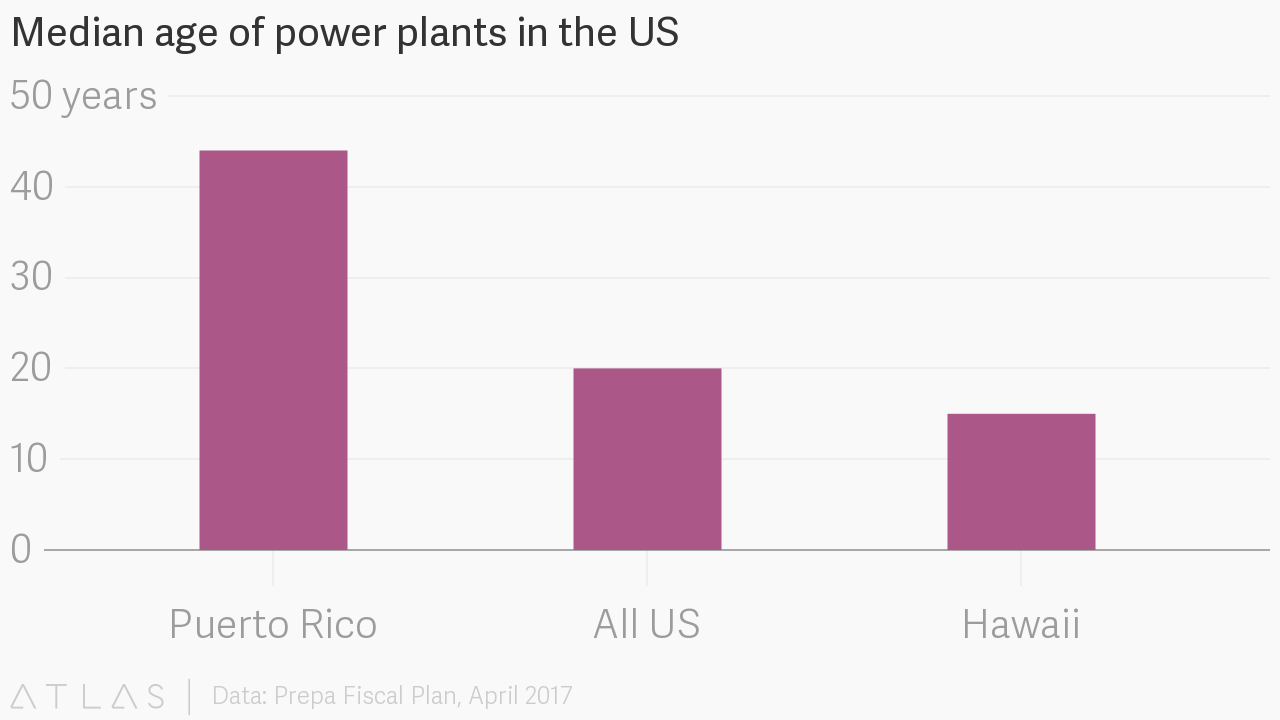
Fossil fuels were once the cheapest and easiest option available for an island with few energy reserves of its own. Not any more; Prepa spends more than $1 billion a year on fuels. It was already on track to violate federal pollution rules unless it revamped its technology.
Prepa is also losing customers. The government’s repeated failed attempts to jumpstart Puerto Rico’s economy have prompted waves of emigration to the US mainland. The worst one yet began in 2006, when tax incentives for attracting manufacturing were phased out. Industrial electricity use took a dive, followed by commercial and residential use.
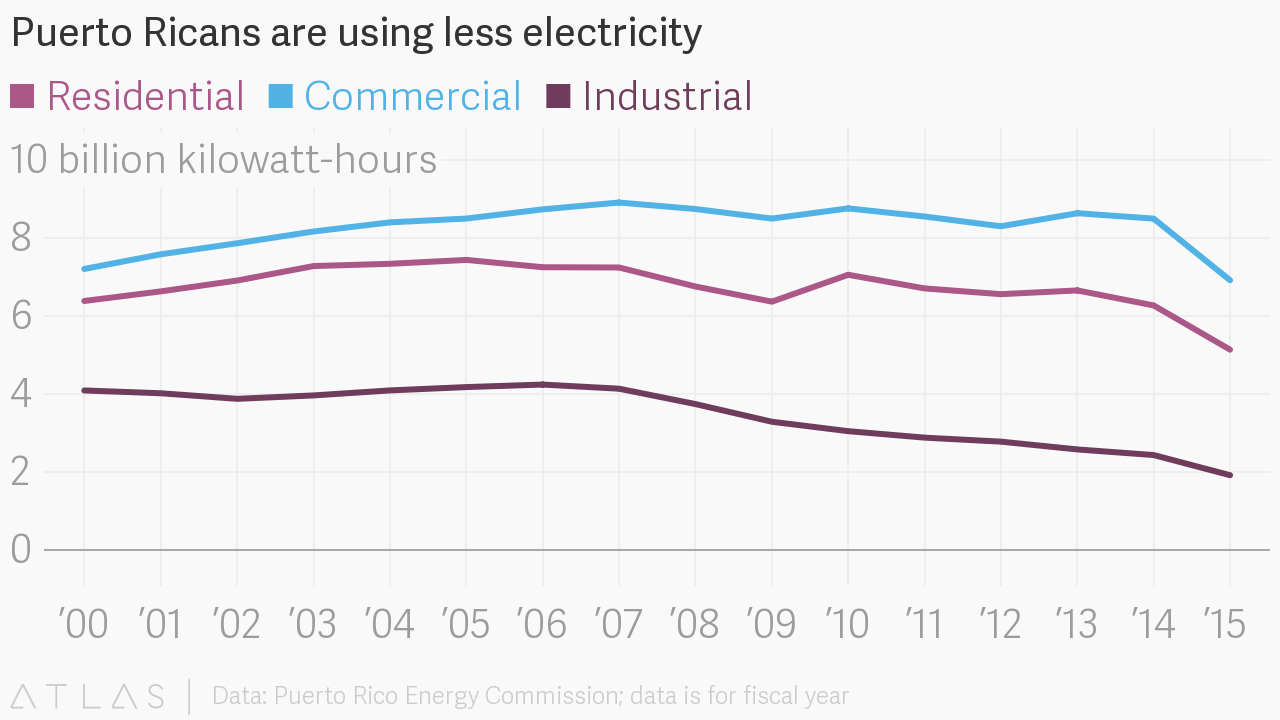
Though Prepa charges higher rates than in much of the US, it can’t cover its costs. So it’s had to scrimp on maintenance and borrow heavily just to keep running. Since 2010 its debt has ballooned.
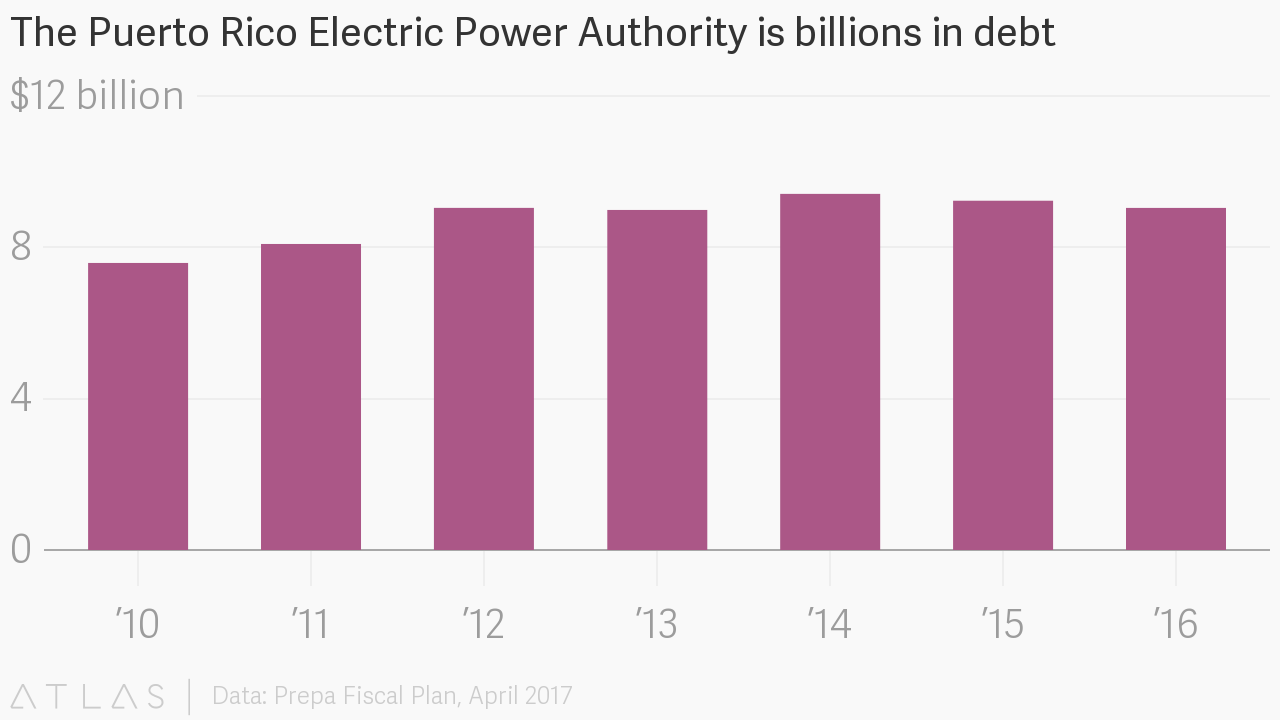
Prepa filed for bankruptcy in July and is under the supervision of the Financial Oversight and Management Board, known locally as just La Junta (“The Board”)—a US government-appointed body that is representing it in bankruptcy court.
A Shrinking Prepa
Even before Maria, some island residents had been migrating to a Prepa-less world. Doris Claudio, who owns a dairy farm in San Lorenzo, southeast of San Juan, installed solar panels about seven years ago to milk her roughly 200 cows. The solar array cut her monthly bill from $3,000 to around $1,200, she says. She was about to install a second set of panels when Maria swept through, damaging her existing ones. That hasn’t dissuaded her: She’s planning to repair them and add the second batch. “We can save up a lot of money that way,” she says.
It’s not just small businesses that are switching to solar. Aireko, a construction company with more than 700 employees, runs its headquarters in Caguas entirely on solar panels. The president of its board, Josen Rossi, has been lobbying for an overhaul of Puerto Rico’s electric system through the Institute for Competitiveness and Sustainable Economy (ICSE,) a non-profit that Aireko co-founded.
Tomás Torres, ICSE’s executive director, says Puerto Rico needs to move away from Prepa’s model of central electric generation towards one of smaller providers more evenly spread throughout the island—including consumers who make their own energy through sources such as solar and feed the excess back into the grid. The resulting network would be more efficient and more resilient, he says.
Before the storm, Prepa had been resisting such moves. Last year, it tried to charge non-residential customers who installed new solar panels 3 US cents per kilowatt-hour for energy they themselves generated. (It desisted after ICSE challenged it in court.) Now, in theory, it should be crediting customers who supply their excess solar power to the grid, but it’s still dragging its feet, according to Arturo Massol at Casa Pueblo, an environmental grassroots group. The agency hasn’t completed the paperwork for Casa Pueblo to get these credits; instead it’s just absorbing the energy Casa Pueblo produces, without paying.
Prepa did not respond to requests for comment.
Solar Revolution?
With Prepa crippled by the storm, Massol and others see a golden opportunity. After more than a month and a half without power, Puerto Ricans who already wanted a better system are now desperate for it. As of Nov. 9, the company had brought only a little over 40% of its generating capacity back online; eight hospitals were still operating without grid power.
On a recent afternoon, residents of the barrios sprinkled atop Adjuntas’s hills crowded around Massol. He was distributing solar lamps, now a coveted commodity. “For many people it’s a revelation that they can get power from the sun,” says the bearded biologist.
His group is using the lantern handouts—it’s distributed 5,000 so far—to educate people about its alternative energy initiatives. They include solar-run refrigerators, energy-independent communities, and an ultimate goal of getting half the island’s energy from the sun. Casa Pueblo has already amassed a small fund, from hurricane relief donations, to use in these efforts. “Sometimes you have to be an energy guerrilla,” Massol says.
Solar power companies are moving just as quickly to set up micro-grids: local power systems with battery storage, which can operate independently from the main grid. Houston-based Sunnova, which already has some 10,000 customers with solar panels on the island, is sending them batteries. Tesla switched power back on at the children’s hospital in San Juan, “the first of many solar+storage projects” in the island, the company tweeted. Sonnen, a German manufacturer of solar energy-storage equipment, has also donated 15 micro-grids.
Such setups could help ease the power shortages while Prepa is still busy rehanging power lines, but once the grid is back up they’ll also serve to eat away at its monopoly on generation. It took San Francisco-based Sunrun a couple of days to install donated panels and batteries at the fire station in Barrio Obrero, a working class neighborhood where wet mattresses and other hurricane debris still await collection. While the power is out, the equipment is keeping the station’s communications running, along with a small fridge for cold drinks—much appreciated in San Juan’s sticky heat.
Puerto Rico’s misfortune, therefore, has the potential to turn the island into an unexpected solar energy showcase. In other places, proponents of solar have to work with an existing grid; in undeveloped areas, with no established grid, there’s usually no need for it. In that sense, Puerto Rico is unique. “The demand is there and the infrastructure isn’t,” says Chris Rauscher, Sunrun’s public policy director.
Natural Gas
But the solar industry isn’t the only one interested in Puerto Rico. The Center for Liquefied Natural Gas, or CLNG, a trade group for natural gas producers and transporters, is expecting the industry to grow on the island. “As Puerto Rico rebuilds in the shadow of hurricane Maria, it can continue to look to LNG, to bring affordable, reliable, and clean energy to the island,” its head, Charlie Riedl, said in a statement.
The natural gas industry has powerful allies in Congress, which is currently weighing how to use federal funds to help rebuild Puerto Rico’s power system. One such ally is Rob Bishop, a Utah Republican congressman who heads the House Committee on Natural Resources. He helped pass Promesa, the law that allowed Prepa to file for bankruptcy; he is also a longtime fan of fossil fuels. Bishop said back in early September—before Maria—that Puerto Rico needs an LNG port to get off its dependence on oil.
Prepa itself was leaning towards natural gas before Maria. In the fiscal plan it submitted in April to La Junta, its bankruptcy overseer, it proposed to multiply its use of renewable energy six-fold by 2026. But it would also use more natural gas and stay mainly reliant on fossil fuels.
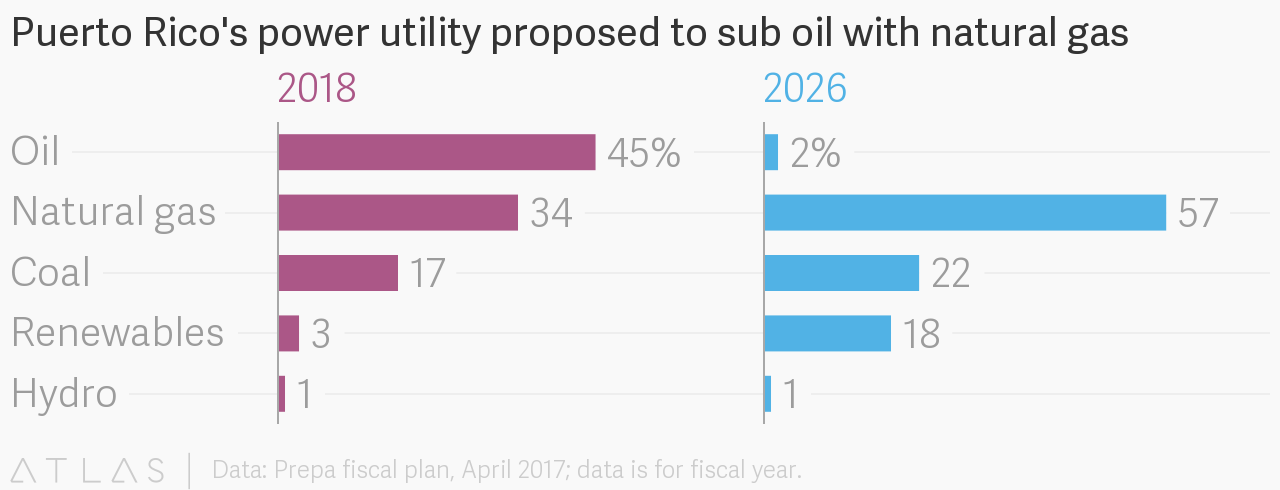
Now any assumptions made before the hurricane will have to be revised, La Junta’s head told a congressional hearing on Nov. 7. Competing visions for Prepa surfaced during the three-hour affair: Some Congress members touted solar energy, others natural gas. Junta executives said they are considering privatizing parts or all of the utility.
That’s assuming they get to make the decision. La Junta and Prepa are locked in a legal battle over how much power the board has over the public company. La Junta wants to name a retired Air Force colonel as the utility’s “chief transformation officer” with powers equivalent to a chief executive; Prepa and the Puerto Rican government say it doesn’t have that right. A bankruptcy judge will hear their arguments on Nov. 13.
The fight is a reminder that despite the variety of interests vying to remake Prepa, the utility itself retains a big say in its own future. “Everyone is taking for granted that given the situation, Prepa’s management is open and willing to change, but the corporate culture there is very strong,” says Marxuach, the energy policy expert at the Center for a New Economy.
An example of that: the $300 million contract to repair transmission lines the utility signed in September with Whitefish Energy, a small Montana company with little experience and ties to US interior secretary Ryan Zinke. After hammering out the deal, Prepa kept Puerto Ricans in the dark on its details for weeks. It pulled out, reluctantly, only after the news landed on the front pages of mainland newspapers. Congress members were intending to grill Prepa’s director Ricardo Ramos about the Whitefish contract at the Nov. 7 hearing, but he didn’t show up.
Ana Campoy is Latin America reporter for Quartz, where this article was originally published.

NEXT STORY: Who's really responsible for cloud security?
